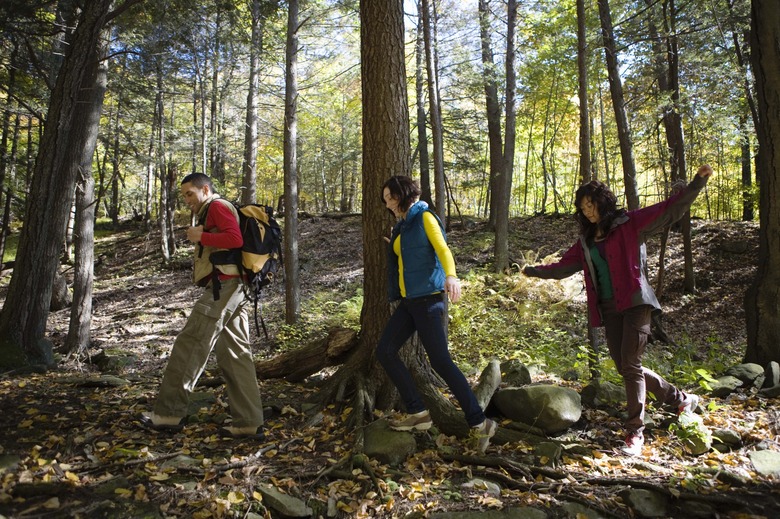Edible Wild Plants In Alabama
Alabama's woods, fields and even backyards are filled with gorgeous lush plant life thanks to the pretty consistent high temperatures and moist air. Not many people know that many of these wild plants that are native to Alabama are actually edible.
But before you go picking a plump berry off of a strange bush, you want to make sure you're not actually eating something that's toxic or poisonous. This is especially true since some edible plants in Alabama look similar to non-edible ones.
Edible Wild Berries
Edible Wild Berries
Blackberry bushes can be found all over the state of Alabama (along with many states on the United States' East Coast in general). In the wild, these bushes/shrubs are often called brambles.
They also tend to grow in huge impassable thickets with thorny stems that can be 13 feet high and up to 40 feet in length. They can also be identified by their plump black berries that grow all over the shrub along with flowers that have five white petals.
Besides the sweet and tart berries, a blackberry bush also has edible leaves and roots. Most people dry the roots and leaves and make them into a tea.
Muscadine
Muscadine
Muscadine is a type of wild grape that can also easily be found all over the southeastern United States. The fruit on these vines can get huge with some grapes the size of a golf ball. The coloration of the fruit can range from green to dark purple.
The skin on these fruits are tough and eating them raw is more like eating a peach than eating a classic grape. It's because of this that many people use muscadine grapes to make jelly, jam, juice and muscadine wines.
These grapes are Alabama's natural superfood: They have high levels of antioxidants, resveratrol and ellagic acid (a compound found in no other wines that's been connected to reduced obesity levels).
Cattail
Cattail
Cattails are common plants in any wetland and/or marsh area as they're mostly aquatic. They're easily spotted and identified with their thick brown tube topping a long and green stem. They're also often found in groups together, which makes them hard to miss.
Almost all parts of this plant can be used and eaten in some way. The edible leaves of the cattail can be used in salads or steamed and eaten like spinach. The stems of the plants can be boiled or eaten raw.
The root of the plant is probably the most commonly eaten part of the plant. It's described as tasting starchy and similar to potato.
Pecan Trees
Pecan Trees
Pecan pie is one of the most quintessentially desserts of the entire state of Alabama thanks to the native pecan tree found throughout the state (and the south in general). It's even featured on the Alabama state symbol.
Growing up to 100 feet tall, these trees produce their tasty nuts throughout their lifetime. The taste of the nut is described as buttery and rich.
Dandelions
Dandelions
Dandelions are seemingly ubiquitous throughout the United States, including Alabama. While these weeds might not look as delicious as a blackberry or a pecan, the base of the flower can be cooked and eaten. These are known as dandelion greens and they're actually considered wild herbs.
Besides the greens, you can eat the flower, root and leaves as well.
Fiddleheads
Fiddleheads
Fiddleheads are technically fern fronds that haven't unfurled yet. People describe the taste as green bean- and asparagus-like. They look like coiled snail shells that are a natural, pale green. If you're harvesting them yourself, make sure they're tightly coiled and have no evidence of browning.
Once harvested, cleaned and ready to cook, throw them in a pan with some garlic and butter and you'll have a delicious side of Alabama-grown greens.
References
- SF Gate: How to Identify Blackberry Plants
- OA Now: Many Wild Alabama Plants Useful for Food, Medicine
- Wine Folly: Guide to Muscadine Wine
- Edible Wild Food: Cattail
- Arbor Day Foundation: Pecan Tree
- Smithsonian Magazine: What the Heck Do I Do with Dandelion Greens?
- New England Today Food: How to Cook Fiddleheads
Cite This Article
MLA
Walsh, Elliot. "Edible Wild Plants In Alabama" sciencing.com, https://www.sciencing.com/edible-wild-plants-alabama-6146170/. 26 June 2019.
APA
Walsh, Elliot. (2019, June 26). Edible Wild Plants In Alabama. sciencing.com. Retrieved from https://www.sciencing.com/edible-wild-plants-alabama-6146170/
Chicago
Walsh, Elliot. Edible Wild Plants In Alabama last modified March 24, 2022. https://www.sciencing.com/edible-wild-plants-alabama-6146170/
